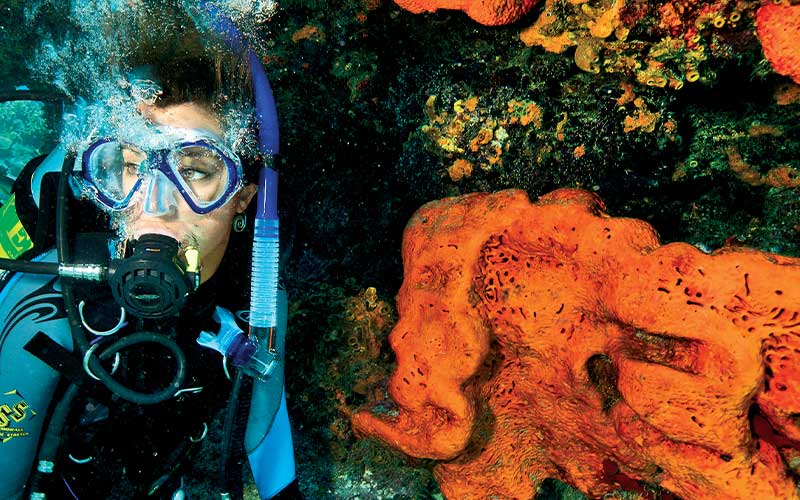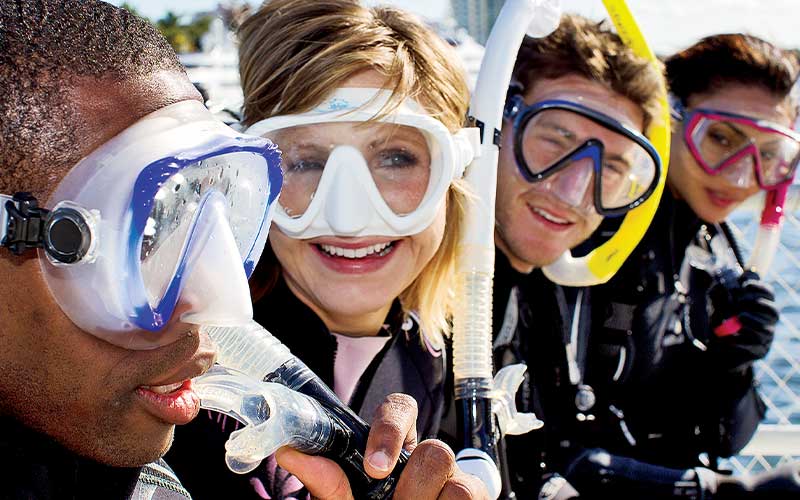A mask is one of the most critical pieces of gear in any dive bag. Without it, the entire point of venturing into the depths is virtually moot. The mask’s basic concept is simple: It provides an air space between the face and the water, allowing the eyes to focus properly for a clear view of the underwater world.
While their purpose is simple, masks come in an amazing array of sizes, types, styles and prices, from simple, single-pane masks at less than $100 to pricier full-face masks and those sporting technology that displays dive data. Regardless of a mask’s complexity, when it comes to choosing the right one, it usually comes down to a few basics.
Features
Size/volume — One of the first factors to consider is a mask’s size. Many modern masks strive for a close fit, and that can be a real benefit. A close fit means a small mask volume; the smaller the volume, the less air is required to clear the mask of water. Low volume also means less buoyancy, which translates to better trim and reduced neck strain.
Purge function — Some masks offer a purge function or a one-way flapper valve that allows the diver to clear the mask simply by exhaling into it. While the benefits of the function are easy to see, the downside is the valves sometimes leak.
Nose/pinch pockets — One of the most important features of a dive mask is the nose or, less commonly, the pinch pockets, either of which permits divers to block their noses to allow equalization of the ears. Whether your mask features a nose or pinch pockets, if you dive in cold water make sure you are able to pinch your nose while wearing your gloves or mitts.
Panes — Most masks designed for diving have faceplates and panes made of tempered glass. In addition to the shatter protection tempered glass offers, it is generally scratch resistant and has better anti-fogging characteristics than plastic. Some masks offer only the faceplate, while others have side panes, letting in more light and allowing some peripheral vision. While the greater field of vision has its advantages, multipane masks tend to have larger volumes than single-pane masks.

Skirt material and seal — Most contemporary mask skirts are made of silicone, which is flexible and less prone to ultraviolet light damage than rubber. The silicone is available in a variety of colors, although clear silicone allows the most light to enter the mask, a benefit to divers for whom masks feel confining. The silicone also provides a better seal, as its flexibility conforms to the contours of a diver’s face.
Strap type — All masks should have an adjustable strap to hold the mask in place. A split strap generally secures the mask by pulling it against the face and nose. Many divers prefer the comfort of a broad neoprene strap, which is less likely to tangle in the diver’s hair. No matter the material, make sure the mask strap is adjustable and locks securely in place.
Full-face masks — Full-face masks are great for cold or contaminated water, and they are generally much more compatible with underwater communication systems. While that is undoubtedly beneficial in some situations, full-face masks are certainly more expensive than their partial-face counterparts, and they require additional training and skills to use properly.
Heads-up technology — If price is not a concern, consider one of the new designs that integrates a dive computer and wireless pressure receiver into the mask, providing critical information such as depth, time, air pressure and decompression status in a heads-up display. These masks are great for divers who dive in low-visibility conditions, at night or with both hands occupied.
Corrective lenses — People who wear glasses or contacts may wish to try a custom-made mask with prescription lenses. Many divers who are comfortable in their soft contact lenses simply wear those while diving, but prescription masks can really improve the diving experience for people who wear glasses or hard contacts, which aren’t recommended while diving.
Checking the Fit
The fit of the mask is the most important factor in creating a watertight seal. To check the fit of a mask, hold it to your face and press gently. The mask should form a seal and be free of any gaps or pressure points. Since the shape of our faces changes when we have a regulator or snorkel in our mouths, it is best to perform the fit check with a mouthpiece in place.

Care and Maintenance
Avoid leaving your mask out in the sun, and always store it in a cool, dry location where it is protected from impact with other equipment. A dedicated storage box or bag provides protection and prevents the skirt from becoming deformed during storage and transport.
To reduce fogging, clean the faceplate of a new mask inside and out with toothpaste to remove any film left in the manufacturing process. Commercial anti-fog solutions are available, although saliva may work just as well. Spit or dispense the anti-fog solution on the inside of the mask, rub until it squeaks, then rinse with water. After diving, rinse the mask with fresh water, and allow it to dry before storage. Most dive boats separate mask rinse bins from camera rinse bins, since some mask defog agents may damage housing O-rings or ports.
Shooter Masks
By Stephen Frink

While many underwater photographers prefer their models wear clear silicone masks, which allow for better illumination of the models’ eyes, they themselves tend to use black-skirted “shooter masks.” This is because light coming through the sides of a mask via clear silicone or side panes will strike a viewfinder, reducing contrast and making it more difficult to discern fine detail.
I wear reading glasses, so I have another addition to my personal shooter mask. Seeing the small type on my camera’s electronic display and some of the detail on my dive computer can be difficult, particularly in low light, so I have a small diopter (magnifying lens) built into the lower left portion of one of the lenses on my mask.
The anti-fog aspect of mask maintenance cannot be overstated. It’s important to take the time to scrub masks with soft scrub, toothpaste or a commercial scrub. A face mask is the portal to the beauty of the underwater world, and proper preparation and defog are essential for enjoyment and efficiency.
© Alert Diver — Q3 Summer 2011